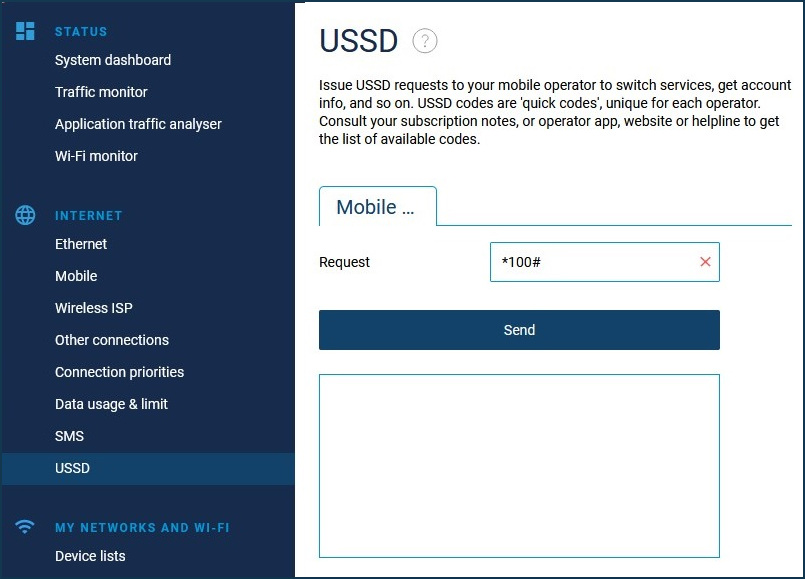USSD
Starting from KeeneticOS 3.5 for compatible QMI modems, Keenetic Hero 4G+ (KN-2311), Runner 4G (KN-2211) and previous generation Hero 4G (KN-2310), Runner 4G (KN-2210) models with internal 4G/3G modem, it is now possible to send a USSD request to your mobile operator.
USSD (Unstructured Supplementary Service Data) is a standard service in mobile networks that allows for interactive interaction between the network subscriber and the service application via short messages. USSD is usually used to request the available account balance and to manage services.
In the web interface, in the 'Internet' menu section, click on 'USSD'. Enter the USSD command (request code) in the 'Request' field and press the 'Send' button.
Важливо
Codes for USSD requests vary from operator to operator. Please check the list of codes supported by your operator.

Примітка
Sending USSD requests works in 'Auto' and '3G only' modes but does not work in '4G only' mode. This is due to the limitations of USSD technology and is relevant for all vendors and operators. If in 'Auto' mode, a modem works in 4G; then, when sending USSD, in the web interface you can see how the router temporarily switches from 4G to 3G and then back to 4G.
The router's command-line interface (CLI) uses the ussd send command to send the USSD request.
The command's full syntax is:
(config)> ussd {interface} send {request}
{interface} is the full interface name or alias; the list of available interfaces can be seen with the interface [Tab] command. The built-in 4G/3G modem in Hero 4G (KN-2310) and Runner 4G (KN-2120) models has the default interface name UsbQmi0.
{request} — USSD command.
Example of a USSD request command:
(config)> ussd UsbQmi0 send *100#
request: *100#
response: Your number: +1234567890
Available: 10 dol
4.01 / 5 GBThe procedure for sending USSD requests in dialogue mode is as follows:
First, we send a USSD request with selectable response options. Let's imagine that a request for disactivation of a certain service looks like this:
*111*38#
In reply, we receive:
Activate the service? 1>Activate 2>Disactivate 3>Info 0>Back
Then, in the second message, include the original request without
#and add to it a*and the answer option2 (Disactivate), end the message with#:*111*38*2#
We receive:
Request sent, upon registration you will receive an SMS